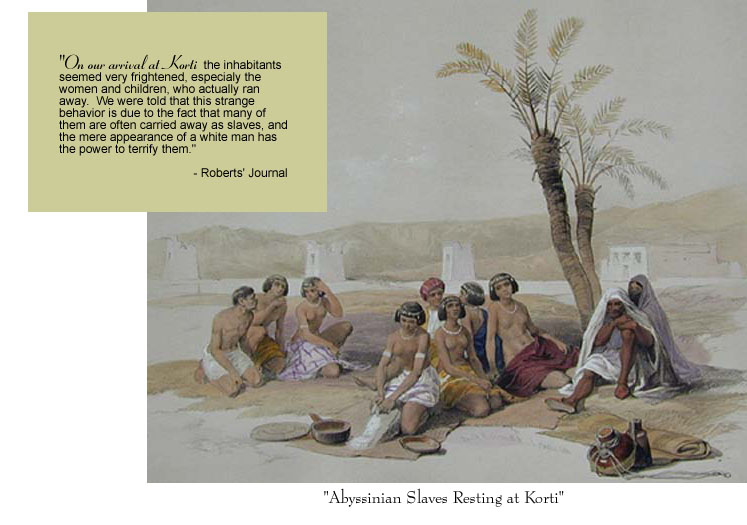
Roberts now parted company with his traveling companions, who continued up-river to view the second cataracts of the Nile. Traveling downstream at a more leisurely pace, Roberts began his practice of sketching the local population as well as the monuments, and of including them in his finished works. Sometimes this was done to convey the scale of the buildings, but often people were the central subject of a scene. The quality and life of these figures also distinguishes Roberts' images from those of other artists, whose figures often seem incidental and static by comparison.
Though typically European in much of his outlook, Roberts was in some respects a surprisingly broad-minded traveler. Slavery was still common in Egypt and Roberts was appalled. He was quick to credit the intelligence of the citizens of all races, was respectful of their customs, and careful not to deface or carry away any parts of the monuments he visited, in contrast to the habits of most western travelers of the time.

From Korti Roberts continued down river to the Island of Philae, just above the present day Aswan Dam. At the time of Roberts' visit the Nile had not yet been dammed, and many of the temples along it had only recently been freed from their mantles of sand. The Egyptians' intense use of colors painted on the stone was still very much evident, at Philae in particular. Much of that coloring has faded or disappeared entirely over the last 150 years. Philae suffered even more when in the early 1900's the first Aswan Dam was built, inundating it for much of the year and speeding the obliteration of its colors. When the second, much larger Aswan Dam was to be built in the 1960's, Philae would have completely disappeared under the reservoir, as would the temple of Abu Simbal further upstream. Both of these huge monuments were disassembled piece by piece and moved to higher ground, in the case of Philae to another similarly shaped island. Roberts' drawings of the Nile temples, made when they were still brightly colored, are now invaluable reference tools as well as unique artistic records of now sadly lost grandeur. (View the lithographs of Philae.)
From Philae Roberts journeyed past the temples of Kom Ombu and Edfou to the great complexes of Karnak and Luxor, at the "Valley of the Kings".